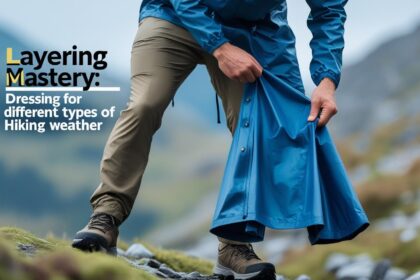
Learn how to expertly layer your clothing for any hiking weather with this comprehensive guide on the three-layer system and essential tips for staying comfortable and safe.
Introduction to Hiking Layering
Layering is essential for hikers who face a wide range of weather conditions on the trail, as it provides the flexibility and adaptability needed for comfort and safety. The three-layer system—comprising a base layer, mid layer, and outer layer—ensures that hikers can effectively manage their body temperature while responding to changing environmental conditions. Each layer serves a distinct purpose: the base layer wicks moisture away from the skin to keep you dry, the mid layer offers insulation to retain body heat, and the outer layer acts as a protective barrier against elements like wind and rain. This thoughtful arrangement is critical, as it helps maintain body temperature and comfort, which are vital for performance and safety during outdoor activities.
Consider a scenario where you embark on a hike that starts off sunny but quickly transitions into a rainstorm. If you have layered appropriately, you can easily adjust your clothing to adapt to these unexpected changes. This preparedness not only enhances your experience but also safeguards against hypothermia in cold conditions and overheating in warmer weather. The psychological comfort that comes from being ready for whatever Mother Nature throws your way is invaluable, allowing you to enjoy the beauty of your surroundings without worrying about the elements. Being equipped with the right layers not only enhances your overall hiking experience but also increases your safety on the trail, making it a critical consideration for anyone venturing outdoors.
Understanding the Three Layers
Base Layer
Choosing the right base layer thickness is also critical and should be determined by the temperature range you’ll be hiking in. In milder conditions, a lightweight base layer may suffice, while colder climates might require a heavier option to provide adequate insulation. You should also pay attention to the fit; a snug base layer enhances moisture-wicking capabilities, while a loose fit may allow moisture to linger against your skin. Avoid cotton materials, as they retain moisture and can lead to chilling when wet, which is particularly dangerous in cold weather.
Another factor to consider is the versatility of your base layer. Some hikers prefer to invest in base layers that offer additional features, such as UV protection or odor resistance. For example, many synthetic fabrics come with built-in UPF ratings, which can protect your skin from harmful UV rays during sunny hikes. This added layer of protection can be a game-changer, especially for long hikes in exposed areas. Lastly, don’t underestimate the importance of personal preference; finding a base layer that feels comfortable against your skin can significantly enhance your overall hiking experience.
Mid Layer
The mid layer serves as an insulation barrier, helping to trap body heat while allowing moisture to escape. This layer is essential for maintaining warmth, especially during colder hikes. There are various materials to choose from, including fleece, down, and synthetic insulation, each with its own set of benefits. For example, a fleece jacket can be an excellent mid-layer option, as it is lightweight, breathable, and dries quickly. Imagine wearing a cozy fleece pullover during a chilly morning hike; it not only keeps you warm but also allows for ease of movement.
When selecting a mid layer, consider the conditions you’ll be facing. Fleece is versatile and suitable for many situations, while down offers an excellent warmth-to-weight ratio, making it ideal for situations where every ounce counts. Synthetic insulation, on the other hand, retains heat even when wet, making it a reliable choice for rainy or snowy conditions. An example would be a synthetic insulated jacket that stays warm during unexpected rain showers, allowing you to continue your hike without discomfort.
Adjustability is another key feature to look for in mid layers. Many mid layers come with zippered vents or adjustable hems, allowing you to regulate your body temperature during periods of intense activity. For instance, if you find yourself climbing a steep trail, you can unzip your mid layer to release excess heat without needing to remove it entirely. Layering multiple mid layers can also provide additional warmth without excessive bulk, enabling you to customize your insulation based on the specific conditions you encounter. Being mindful of how each layer interacts with the others can make a significant difference in your comfort level while hiking.
Outer Layer
The outer layer is your first line of defense against environmental elements, including wind, rain, and snow. It is crucial for protecting your other layers and preventing heat loss. Quality outer layers should be both weatherproof and breathable, allowing moisture from your body to escape while keeping the elements out. High-performance materials such as GORE-TEX are popular choices for waterproofing and breathability, effectively fending off rain while allowing sweat to escape. Picture yourself in a lightweight, packable rain jacket that keeps you dry without weighing you down, allowing for greater mobility on the trail.
When selecting an outer layer, consider features like adjustable hoods and cuffs, which enhance protection against the elements by creating a snug fit. For example, a jacket with an adjustable hem can prevent wind from entering, keeping you warmer during blustery conditions. Additionally, it’s wise to look for outer layers that are lightweight and packable, as this makes them easier to carry in your backpack when not in use. This way, you can be prepared for any sudden changes in weather without feeling burdened by your gear.
Reflective elements in outer layers can also enhance safety during low-light conditions, which is especially important if you plan on hiking during dawn or dusk. For instance, wearing a jacket with reflective strips can make you more visible to other hikers or trail users, reducing the risk of accidents. Furthermore, consider the fabric’s durability; investing in a high-quality outer layer can withstand the rigors of hiking, including abrasions from branches or rocky terrain. This not only extends the life of your gear but also ensures you are prepared for various trail conditions.
Dressing for Hot Weather
When tackling hikes in hot weather, choosing lightweight and breathable base layers is crucial for effective moisture management. Materials that excel in wicking moisture, such as synthetic fabrics, can significantly enhance your comfort during strenuous activities. For example, wearing a short-sleeve synthetic tee made from polyester can help regulate body temperature while efficiently pulling sweat away from your skin. This allows for better evaporation, keeping you cooler and drier on the trail. Lightweight, breathable fabrics also reduce the risk of chafing, a common concern during long hikes in high temperatures.
To further enhance your comfort, opt for convertible pants and short-sleeve tops that allow for ventilation and adaptability. Convertible pants can easily transition from full-length to shorts, providing versatility as temperatures fluctuate throughout the day. Additionally, lightweight wind jackets can be beneficial for unexpected breezes or light rain that may arise during your hike. These jackets typically pack down small, making them easy to store in your backpack when not needed. Light-colored clothing is also a wise choice, as it reflects sunlight and helps keep you cool.
It’s important to avoid heavy fabrics that can trap heat, which can lead to discomfort and increased perspiration. For instance, opting for quick-drying, moisture-wicking materials can make a significant difference in how you feel during the hike. Staying hydrated is equally critical in hot weather; remember to drink plenty of water to prevent overheating and dehydration. A good practice is to carry a hydration pack or water bottles that are easily accessible, so you can sip water regularly without interrupting your hiking rhythm. By carefully selecting the right materials and layering options, you can enjoy a more pleasant hiking experience, even in the sweltering heat.
Dressing for Cold Weather
When hiking in cold weather, starting with a moisture-wicking base layer is essential to prevent chilling from sweat while ensuring you remain comfortable. Your base layer should fit snugly against the skin to enhance moisture-wicking capabilities. For instance, a midweight polyester long-sleeve shirt can provide a good balance of warmth and moisture management. After selecting the right base layer, a mid layer of fleece or insulated jackets will help you retain warmth, with options adjusted based on your activity level and the intensity of your hike. For example, if you’re engaging in a more vigorous hike, a lighter fleece might suffice, while a down jacket over your base and mid layers can be an effective way to trap heat during less active periods.
Your outer layer must be waterproof and insulated to protect against harsh weather elements while allowing for some breathability to prevent overheating. It’s crucial to ensure that your outer layer has adjustable features, such as hoods and cuffs, to create a snug fit that prevents heat loss through gaps. For instance, jackets with adjustable cuffs can keep out cold air and snow, ensuring that your warmth stays intact even during blustery conditions. Don’t forget to insulate your extremities, as hands and feet lose heat quickly; thermal socks and insulated gloves are essential for maintaining comfort in cold conditions.
When packing for colder hikes, consider layering as a dynamic system that allows for adjustments based on the intensity of your activity. For example, during a steep ascent, you may want to remove a mid layer to prevent overheating, only to put it back on during breaks or descents. Additionally, bring extra accessories like beanies or neck gaiters, which can provide added warmth without taking up much space in your pack. By strategically layering these components and being mindful of your body’s needs, you can effectively combat the cold and fully enjoy your winter hiking adventures.
Dressing for Wet Conditions
When hiking in wet conditions, prioritizing moisture management from the get-go is key. Start with a base layer made from moisture-wicking materials that can keep your skin dry, which is vital in maintaining comfort during physical exertion. For instance, a synthetic long-sleeve shirt will allow sweat to escape while keeping water out. This is particularly important in damp environments, as you want to avoid the discomfort of chilling sweat against your skin.
Your mid layer should be chosen with care, as it needs to provide insulation even when damp. Materials like fleece or synthetic insulation are recommended because they retain warmth despite getting wet, ensuring you stay cozy during your trek. Investing in high-quality, breathable rain gear is equally important, as it allows moisture from your body to escape while protecting you against rain. An outer layer with adjustable features is also vital to maintaining a snug fit that keeps rain out. For example, a jacket with a cinched waist can prevent water from entering through the bottom while allowing for easy movement.
Consider waterproof footwear to keep your feet dry and warm during wet hikes. Waterproof hiking boots can be a game-changer, particularly in muddy or rainy conditions, preventing blisters and discomfort. Some hikers also choose to wear gaiters, which can provide additional protection against water and debris that might otherwise enter through the top of their boots. Keeping your gear dry and well-maintained is essential; ensure that your outer layer is free from dirt and grime, as this can compromise its waterproof capabilities. By choosing the right materials and layering appropriately, you can navigate wet conditions with confidence and comfort.
Adapting Layers for Variable Weather
To prepare for unpredictable weather changes, always carry all three layers: a base layer, mid layer, and outer layer. This approach allows you to be ready for anything, whether it’s a sudden drop in temperature or an unexpected rainstorm. Starting your hike with fewer layers is a smart strategy, as it gives you the flexibility to add or remove clothing based on your activity intensity and any temperature fluctuations you encounter. For example, if you begin your hike in the early morning chill and the sun warms the air as the day progresses, having additional layers packed away can easily help you adapt.
Keep an eye on weather forecasts before heading out, but also be aware of microclimates, especially in mountainous regions where conditions can change rapidly. Utilizing packing cubes or compression sacks can keep your layers organized and easily accessible during your hike. This organization can save you time and energy when you need to make quick adjustments. For instance, having your mid layer readily available in an easily accessible pocket can allow you to add it quickly when temperatures drop during a shaded stretch of the trail.
Monitoring your body temperature throughout the hike is vital; if you start to feel too warm or too cold, it’s a clear indication to adjust your layers. This self-awareness can significantly enhance your comfort and safety on longer hikes. Consider doing a periodic check-in with yourself, assessing how you feel every hour or so. Additionally, be mindful of the time of day; temperatures can drop significantly in the evening, so carrying an extra layer or two can ensure that you’re well-prepared for changing conditions. Adapting your clothing in response to these signals not only enhances your hiking experience but also helps prevent issues like hypothermia or overheating.
Importance of Accessories
Accessories play a crucial role in ensuring your comfort and safety while hiking, particularly in varying weather conditions. Items like hats, gloves, and moisture-wicking socks are not merely optional; they are essential for maintaining warmth and protecting against the elements. For instance, a well-constructed beanie can trap heat effectively while keeping your head warm, and insulated gloves can significantly enhance warmth in cold conditions. Pairing these accessories with a good moisture-wicking base layer can provide a comprehensive defense against the cold, making your hiking experience much more enjoyable.
Moisture-wicking socks are particularly important, as they can keep your feet dry and reduce the risk of blisters. Choosing the right material—such as a wool blend or synthetic fabric—can make a significant difference in your comfort level during long hikes. Imagine wearing a pair of moisture-wicking socks that keep your feet warm and dry, allowing you to focus on the trail ahead rather than discomfort. Gaiters are another accessory worth incorporating into your gear; they provide an extra layer of protection against water and debris, particularly in challenging terrain or during muddy hikes.
Don’t overlook the importance of protecting your skin and eyes; wearing sunglasses and applying sunscreen are essential steps to shield yourself from harmful UV rays, even when temperatures are mild. Additionally, consider bringing a lightweight buff or neck gaiter, which can be versatile in different weather conditions. It can serve as a headband, neck warmer, or even a face mask if needed. These small accessories can provide significant comfort and protection, enhancing your overall hiking experience. Ultimately, taking the time to choose the right accessories can make a world of difference in how you feel during your outdoor adventures.
Layering Tips for Different Activities
Tailoring your layers based on specific activities such as hiking, climbing, or skiing can significantly enhance your comfort and performance on the trail or slope. For example, when hiking, it’s essential to consider not only the distance and elevation but also the pace at which you plan to move. If you’re embarking on a leisurely hike, you might opt for a lighter base layer and a thicker mid-layer to retain warmth during breaks. Conversely, tackling a strenuous climb may require a minimal layering approach with a moisture-wicking base layer and a lightweight shell to prevent overheating while still providing necessary protection against wind and rain.
The intensity of your activity will dictate how many layers you may need; less vigorous activities may require more insulation. For example, while skiing, you may want to wear a heavier mid-layer to maintain warmth during long periods of inactivity on the ski lift, whereas during a fast-paced cross-country ski session, a lighter, more breathable mid-layer could be sufficient. Experimenting with various combinations allows you to discover your ideal layering system, ensuring that you remain comfortable regardless of the conditions.
Keep terrain in mind, as rocky or uneven surfaces may necessitate more supportive footwear and potentially even additional ankle protection. For instance, if you’re planning to hike on rugged terrain, wearing boots with good ankle support and traction can prevent injuries and provide a more stable footing. Adjusting your layers based on the time of day is crucial, as temperatures can drop significantly in the evening. By incorporating these tips into your layering strategy, you can be well-prepared for any hiking adventure, ensuring a safe and enjoyable experience in the great outdoors.


